We may not have the course you’re looking for. If you enquire or give us a call on +44 1344 203 999 and speak to our training experts, we may still be able to help with your training requirements.
Training Outcomes Within Your Budget!
We ensure quality, budget-alignment, and timely delivery by our expert instructors.

Embarking on the dynamic journey of Web Development often leads to the pivotal question: What is jQuery? Introduced by John Resig in 2006, jQuery has evolved into a powerhouse in JavaScript libraries.
Moreover, jQuery serves as a bridge between simplicity and efficiency, offering an intuitive approach to tasks such as DOM manipulation, event handling, and AJAX requests. jQuery is a fast, small, and feature-rich JavaScript library. It simplifies tasks like HTML document traversal and manipulation, event handling, and animation.
Table of Contents
1) What is jQuery?
2) Importance of jQuery
3) Key features of jQuery
4) Advantages of jQuery
5) Conclusion
What is jQuery
JQuery, a potent JavaScript library, stands as a cornerstone in modern Web Development, transforming the landscape with its pragmatic approach and versatility. Born in 2006, the brainchild of John Resig, jQuery was crafted to alleviate the challenges developers faced in interacting with the Document Object Model (DOM) and handling JavaScript events across different browsers.
Now, jQuery essentially simplifies the intricate process of DOM manipulation, enabling developers to seamlessly traverse and manipulate HTML elements with succinct and expressive syntax. Its prowess extends to event handling, providing an intuitive interface for managing user interactions.
The library's support for Asynchronous JavaScript and XML (AJAX) further enhances its capabilities, facilitating dynamic content loading without the need for page reloads. One of jQuery's defining features lies in its animations module, where developers can effortlessly breathe life into web pages through a suite of functions for creating fluid and captivating visual effects. What sets jQuery apart is its commitment to cross-browser compatibility, ensuring that code runs consistently across different environments.
Importance of jQuery
jQuery stands as a linchpin in Web Development, playing a pivotal role in shaping the digital landscape. Its importance lies in its ability to simplify and streamline complex JavaScript tasks, offering developers an efficient and cross-browser-compatible toolkit. By providing a concise syntax for DOM manipulation, event handling, and AJAX requests, jQuery empowers developers to create interactive and dynamic web applications easily.
Additionally, the library's significance extends beyond its technical capabilities. jQuery has become a unifying force in the developer community, fostering collaboration and standardisation. Its widespread adoption has resulted in a wealth of resources, tutorials, and plugins, creating a robust ecosystem that accelerates development workflows.
Even as newer frameworks emerge, jQuery endures as a foundational tool, especially in scenarios where a lightweight, versatile solution is preferred. Essentially, jQuery's importance transcends its features, embodying a legacy of accessibility, community support, and enduring relevance in the ever-evolving Web Development landscape.
Key features of jQuery
jQuery, a powerful JavaScript library, boasts features that simplify Web Development. It excels in DOM manipulation, enabling easy traversal and modification of HTML elements. Event handling is intuitive, AJAX requests are streamlined, and animations are simplified. Its cross-browser compatibility and extensive plugin ecosystem make jQuery a versatile and essential tool for developers.
Here are the many features of jQuery that users can enjoy the benefits of:
1) Selection of DOM elements
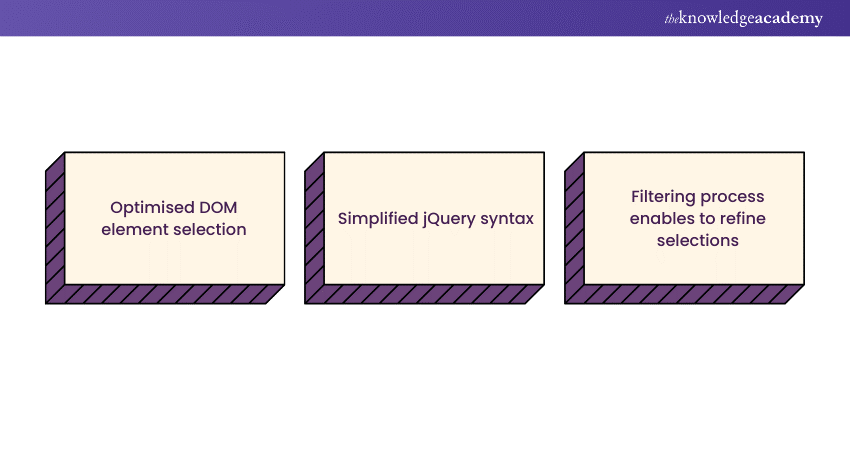
jQuery revolutionises DOM element selection, providing developers with a concise and efficient approach. Using selectors inspired by CSS syntax, jQuery allows for precise identification and manipulation of HTML elements. Whether selecting elements by tag name, class, ID, or hierarchy, jQuery's syntax simplifies the process.
Its versatility extends to filtering, enabling developers to refine selections based on specific criteria. This intuitive selection mechanism significantly enhances the ease and speed with which developers can interact with the Document Object Model, forming a core aspect of jQuery's appeal and contributing to its widespread adoption in Web Development.
2) Manipulation of CSS
jQuery facilitates seamless CSS manipulation, empowering developers to alter the style and appearance of HTML elements dynamically. Developers can effortlessly add, remove, or toggle CSS classes through its intuitive methods, providing a dynamic user interface.
More importantly, animations are simplified, allowing smooth transitions and visual effects. With jQuery, CSS properties can be directly modified, offering real-time adjustments to element styles. This streamlined approach to CSS manipulation enhances the overall responsiveness and interactivity of web applications, making jQuery a preferred choice for developers seeking an efficient and expressive solution for dynamic styling in the ever-evolving landscape of Web Development.
3) Utility functions
jQuery's utility functions are a treasure trove for developers, offering a range of features to simplify common tasks. From checking and manipulating attributes to handling data and events, jQuery provides versatile utility functions that enhance development efficiency.
The library excels in AJAX, streamlining asynchronous data retrieval and manipulation. Additionally, developers benefit from utility functions for easing animations, simplifying form handling, and managing document structure.
Moreover, jQuery's utility functions not only streamline coding but also contribute to cleaner, more readable codebases, making it an indispensable tool for those seeking to optimise their workflows and enhance the functionality of their web applications.
4) Implementation of effects and animations
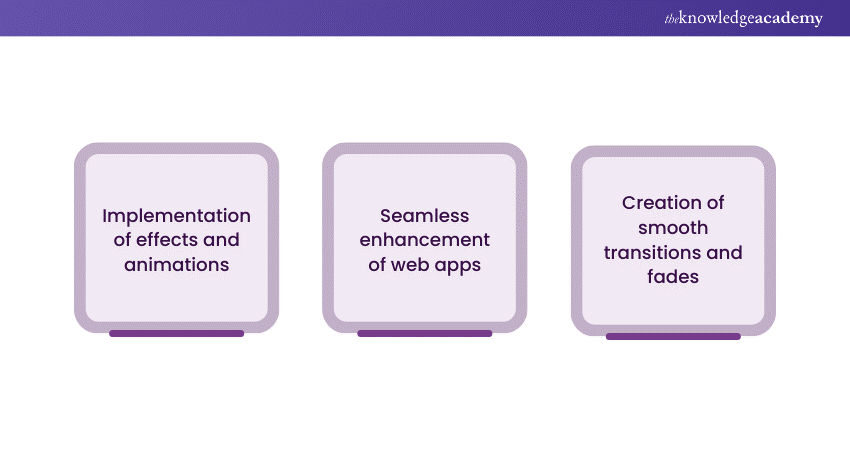
jQuery excels in implementing effects and animations, offering developers a seamless way to enhance the visual appeal of web applications. With a suite of built-in functions, developers can effortlessly create smooth transitions, fades, slides, and custom animations.
The best part is that jQuery's intuitive syntax simplifies the process, allowing for dynamic and engaging user interfaces. Whether revealing content, sliding elements into view, or applying custom animations, jQuery's animation capabilities provide a powerful toolset for developers to bring their designs to life. This feature contributes to jQuery's enduring popularity, especially when it comes to crafting interactive and visually appealing web experiences.
5) Manipulation of HTML
jQuery revolutionises HTML manipulation with its straightforward and efficient methods. Developers can effortlessly traverse, modify, and manipulate HTML elements using concise syntax. Selecting, appending, or removing elements becomes intuitive, enhancing the overall flexibility of Web Development.
jQuery simplifies content insertion, enabling dynamic updates without page reloads. Its methods for handling HTML content, such as text() and html(), offer precise control over data presentation. This streamlined approach to HTML manipulation not only accelerates development but also contributes to creating more responsive and interactive web applications, making jQuery an indispensable tool for developers seeking simplicity and efficiency in their coding endeavours.
6) Parsing JSON
jQuery simplifies JSON parsing, providing developers with a seamless mechanism to handle data interchange. Leveraging the parseJSON() function, developers can effortlessly convert JSON strings into JavaScript objects.
This streamlined process facilitates efficient data manipulation and integration within web applications. Whether fetching data from an API or handling user inputs, jQuery's JSON parsing capabilities ensure smooth communication and interaction.
The library's approach to JSON parsing enhances code readability and maintainability, contributing to a more straightforward and effective development workflow. This feature underscores jQuery's versatility, making it an invaluable tool for managing and processing JSON data in the dynamic landscape of Web Development.
7) Extensibility through plug-ins
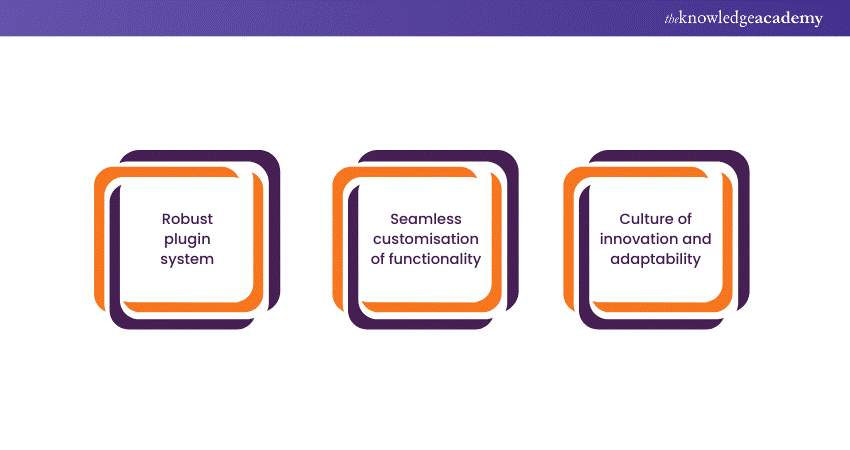
jQuery's extensibility shines through its robust plugin architecture, empowering developers to augment and customise functionality seamlessly. The library's simplicity and flexibility facilitate creating and integrating plugins, extending its core features.
With a vast repository of community-contributed plugins, developers can effortlessly enhance their projects with specialised tools and utilities. This thriving ecosystem covers a spectrum of functionalities, from advanced UI components to data visualisation.
jQuery's commitment to extensibility not only fosters innovation but also ensures adaptability to diverse project requirements, solidifying its role as a go-to choice for developers seeking an enriched and customisable Web Development experience.
Enhance your web pages with dynamic effects by signing up for our JavaScript & JQuery Masterclass now!
Advantages of jQuery
jQuery presents a plethora of advantages in Web Development, streamlining complex tasks with concise syntax. Its cross-browser compatibility ensures consistent performance. Simplifying DOM manipulation and event handling, jQuery accelerates development. Extensive plugin support and a robust community bolster its adaptability, making it a preferred choice for efficient and versatile coding.
1) Easy to learn
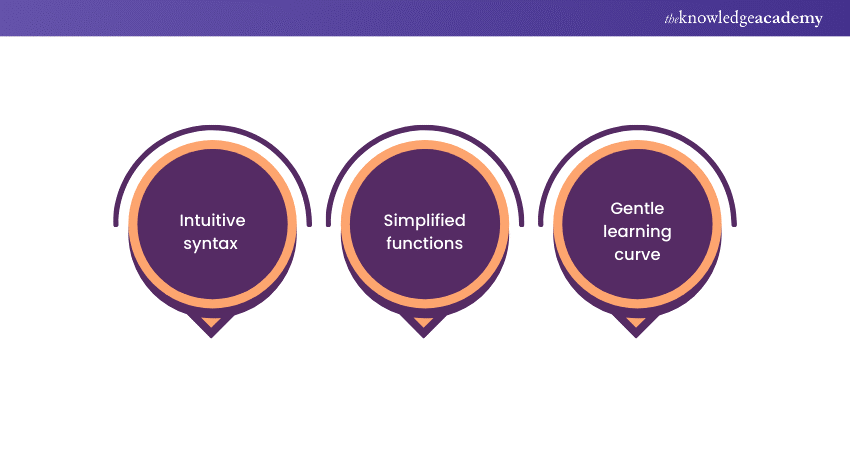
jQuery's easy-to-learn nature is a key allure for developers. With its intuitive syntax and simplified functions, beginners quickly grasp DOM manipulation, event handling, and animation. jQuery's gentle learning curve accelerates entry into Web Development, making it an accessible and user-friendly tool for aspiring and seasoned developers alike.
2) Excellent API Documentation
jQuery's excellence extends to its API documentation, a beacon for developers. It navigates through functions, methods, and concepts with clear and comprehensive guides. This detailed resource simplifies troubleshooting and accelerates development, fostering a supportive environment for developers to harness the full power of jQuery in their projects.
3) Cross-browser support
jQuery's standout feature is its impeccable cross-browser support. Developers revel in consistent functionality across diverse browsers, eliminating compatibility woes. This reliability enhances the user experience, making jQuery a trusted choice for crafting seamless and uniform web applications that perform reliably across various browser environments.
4) Unobtrusive
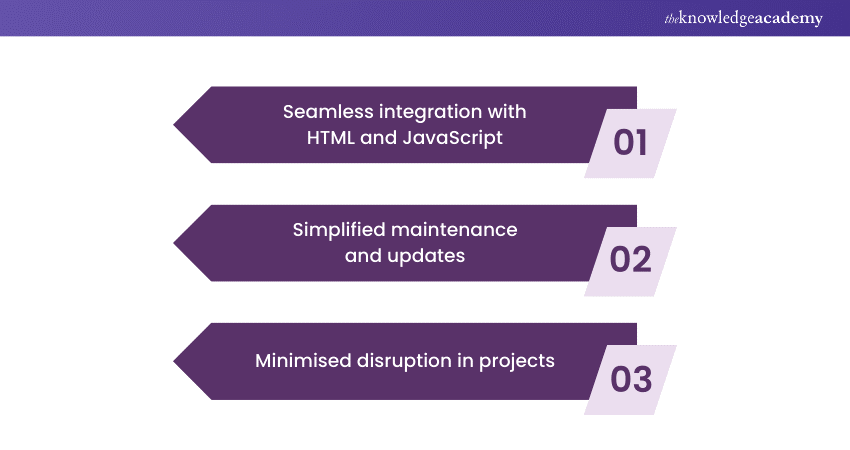
jQuery's unobtrusive nature is a hallmark, allowing developers to enhance functionality without intruding on existing code. It seamlessly integrates with HTML and JavaScript, preserving code clarity. This unobtrusive approach simplifies maintenance and updates, making jQuery ideal for minimising disruption in Web Development projects.
Use the interface and design customised forms by signing up for our JQuery Introduction now!
Conclusion
We hope that you have understood the concept behind “What is jQuery?” and its user-friendly syntax, extensive documentation, and unobtrusive nature, ultimately revolutionising Web Development. jQuery is a versatile toolkit that streamlines tasks, provides cross-browser support, and fosters a vibrant plugin ecosystem. jQuery remains a cornerstone, empowering developers to create dynamic, efficient, and visually compelling web experiences.
Frequently Asked Questions

jQuery, introduced by John Resig in 2006, is a powerful JavaScript library that simplifies Web Development. It's used to streamline tasks like DOM manipulation, event handling, and AJAX requests, offering a concise syntax. With broad browser support and an extensive plugin ecosystem, jQuery enhances efficiency, making it a preferred tool for developers.

jQuery is not a programming language but a powerful JavaScript library. It provides a set of pre-written JavaScript code that simplifies common Web Development tasks. Acting as a tool, jQuery streamlines tasks like DOM manipulation, making it a valuable resource for developers working with JavaScript in Web Development.

jQuery caters to a diverse user base, including web developers, designers, and beginners in JavaScript. Experienced developers leverage its efficiency; designers appreciate its ease of use for creating interactive elements. At the same time, beginners find its simplicity and comprehensive documentation beneficial for confidently learning and implementing Web Development concepts.

The Knowledge Academy takes global learning to new heights, offering over 30,000 online courses across 490+ locations in 220 countries. This expansive reach ensures accessibility and convenience for learners worldwide.
Alongside our diverse Online Course Catalogue, encompassing 17 major categories, we go the extra mile by providing a plethora of free educational Online Resources like News updates, Blogs, videos, webinars, and interview questions. Tailoring learning experiences further, professionals can maximise value with customisable Course Bundles of TKA.

The Knowledge Academy’s Knowledge Pass, a prepaid voucher, adds another layer of flexibility, allowing course bookings over a 12-month period. Join us on a journey where education knows no bounds.

The Knowledge Academy offers various App & Web Development courses, including Introduction to HTML, UX / UI Design Jumpstart, and Javascript & JQuery Masterclass. These courses cater to different skill levels, providing comprehensive insights into App & Web Development.
Our App & Web Development blogs cover a range of topics related to jQuery, offering valuable resources, best practices, and industry insights. Whether you are a beginner or looking to advance your App & Web Development skills, The Knowledge Academy's diverse courses and informative blogs have you covered.
Upcoming Programming & DevOps Resources Batches & Dates
Date
 jQuery Introduction
jQuery Introduction
Fri 21st Feb 2025
Fri 25th Apr 2025
Fri 20th Jun 2025
Fri 22nd Aug 2025
Fri 17th Oct 2025
Fri 19th Dec 2025







 Top Rated Course
Top Rated Course



 If you wish to make any changes to your course, please
If you wish to make any changes to your course, please


